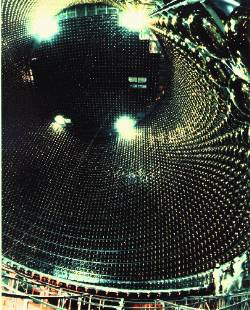5 June 1998
Tiny Particles With Massive Implications
 Scientists in hot pursuit of the Holy Grail of physics, a unified theory of the nature of the universe, have taken a giant leap closer to their goal with the discovery that neutrinos have mass. Questions surrounding the identity of the tiny electrically neutral sub-atomic particles - which can zip ghost-like through the entire Earth without interacting with matter - have haunted physicists for decades. At stake is the very structure of matter, as well as such conundrums as whether the universe has enough mass to reverse, or at least halt, its outward expansion.
Scientists in hot pursuit of the Holy Grail of physics, a unified theory of the nature of the universe, have taken a giant leap closer to their goal with the discovery that neutrinos have mass. Questions surrounding the identity of the tiny electrically neutral sub-atomic particles - which can zip ghost-like through the entire Earth without interacting with matter - have haunted physicists for decades. At stake is the very structure of matter, as well as such conundrums as whether the universe has enough mass to reverse, or at least halt, its outward expansion.
"This finding means we need to take a new look at the theoretical models of the structure of the matter," comments James Stone, professor of physics at Boston University and US spokesman of the joint Japanese-American project that made the discovery. "It sheds light on our basic questions about the nature of the universe, including the question of the validity of the standard model of particle physics."
Announcing their results yesterday [June 4] at Neutrino '98, an international physics conference in Takayama, Japan, the researchers from Boston University, the University of California-Irvine and the University of Tokyo described how they used more than 13 thousand cameras mounted in the massive Super-Kamioka detector tank (pictured) to count and classify the elusive neutrinos. Weighing 50 thousand tonnes and filled with the world's purist water, the 40-metre high tank is buried a kilometre underground in Mozumi, Japan.
Neutrinos are created when high-energy cosmic rays bombard the Earth's upper atmosphere, sending cascades of the elusive particles raining down. Surprisingly, the scientists discovered that a certain type of neutrino had somehow "oscillated" away. According to Einstein, such a transformation can only happen if the neutrino has mass.
"The major problem in physics for the last quarter century has been the problem of mass - where does it come from?" says Lawrence Sulak, a principal investigator. "Until this observation, neutrinos were thought to be massless. Now we know that we have not missed a fundamental symmetry of nature that forbids a neutrino mass. On the contrary, that neutrinos do have mass provides a critical clue in the unification of the particles and forces of nature."
Pic Courtesy of the Super K Project
GoGo Further: Super K at Boston University
